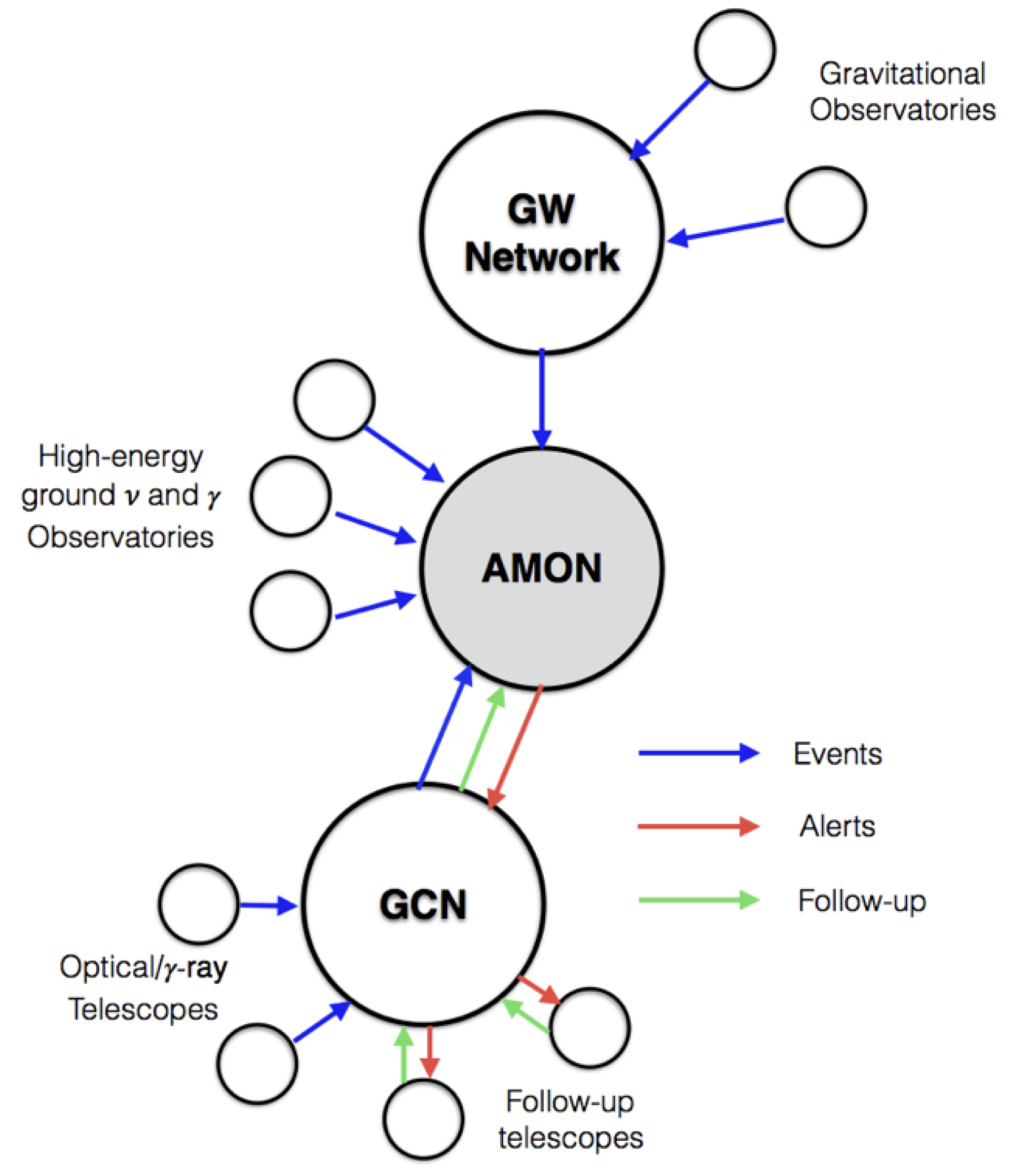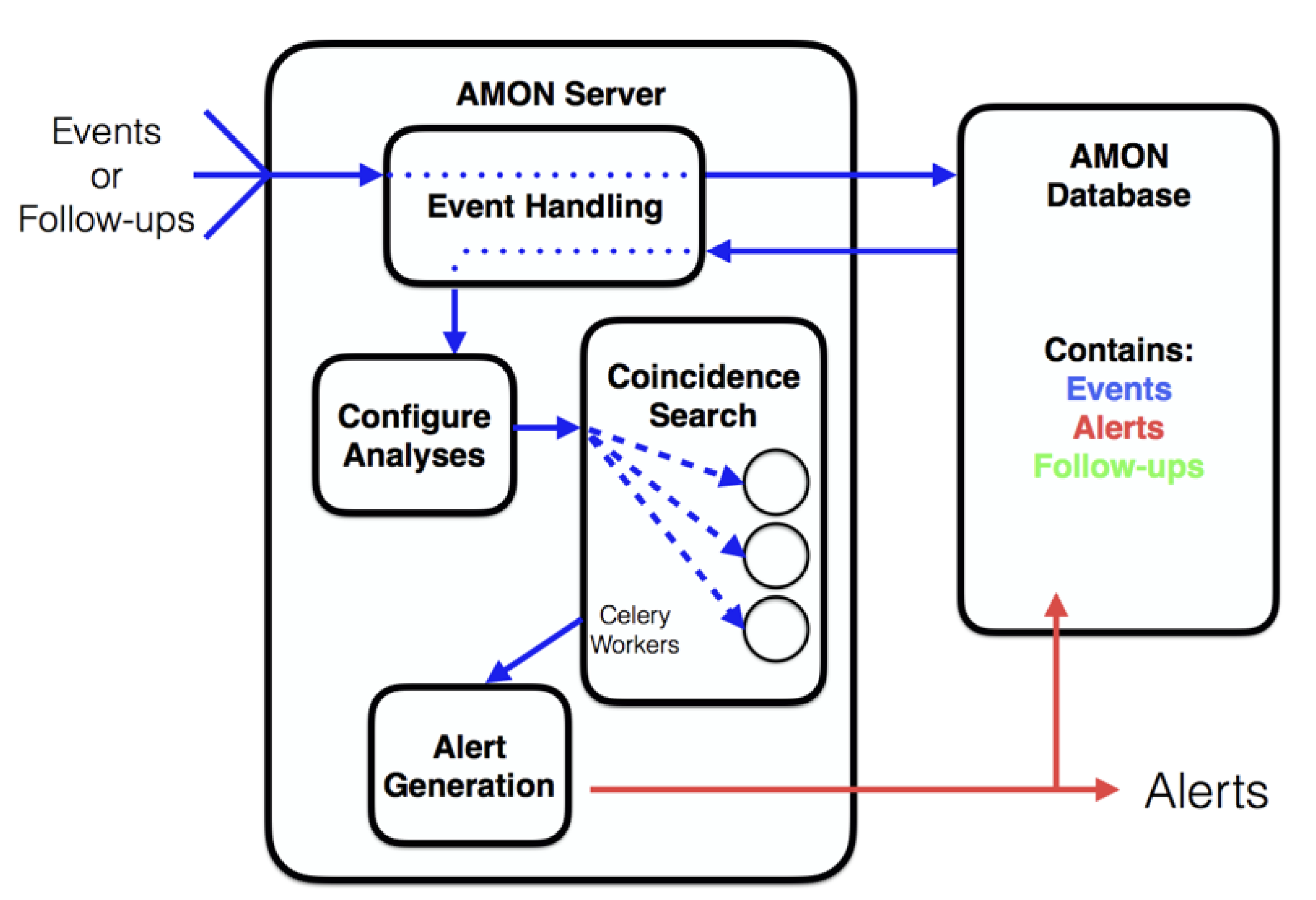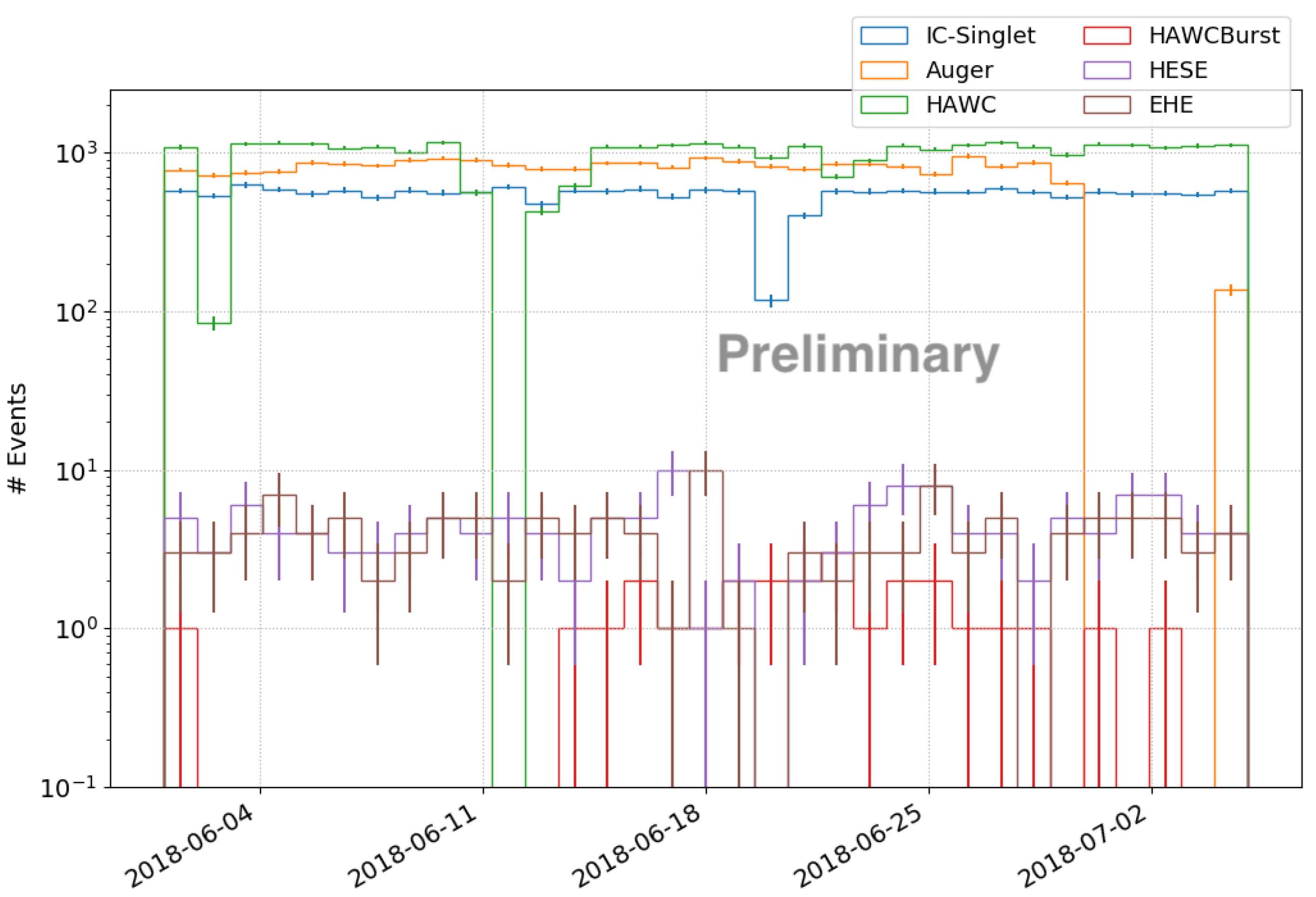AMON Multimessenger Alerts: Past and Future
Abstract
1. Introduction
2. The Astrophysical Multimessenger Observatory Network—AMON
- Search for the sources of ultra high-energy cosmic rays,
- Identification of the sources of high-energy neutrinos,
- Search for non-standard or new exotic phenomena such as primary black holes
- Study of compact binary mergers,
- Study of core-collapse supernovae, main candidates for multimessenger transient phenomena,
- Study of soft gamma-ray emitters, objects that emit bursts of low-energy gamma rays and X-rays,
- Study of active galactic nuclei, galaxies with supermassive black holes in their centers, capable of converting gravitational energy into powerful jets, where particle acceleration occurs.
2.1. The AMON Network
- Triggering observatories have monitoring capabilities due to their high-duty cycles and large fields of view. Observatories in this category that have a memorandum of understaning with AMON are: IceCube [8], HAWC [9], Fermi-LAT [10], Fermi-GBM [11], ANTARES [12], FACT [13], Pierre Auger Observatory [14] and Swift-BAT [15]. Negotiations are on-going with LIGO [16] and Virgo [17].
- Follow-up observatories are usually pointing telescopes, with narrower fields of view but with the advantage of having better sensitivity in less time compared with some of the triggering observatories (as is the case of imaging air Cerenkov telescopes versus water Cerenkov detectors). Follow-up observatories receive alerts through the Gamma-Ray Coordinate Network/Transient Astronomy Network (GCN/TAN) [18]. In some cases, follow-up observatories can trigger on a relevant event, which can then be sent to AMON for coincidence analysis. Detectors in this category that have an MoU with AMON are: MAGIC [19], HESS [20], VERITAS [21], MASTER [22], Swift-XRT [15], LMT [23], LCOGT [24] and ZTF [25].
2.2. Monitoring Capabilities: Hardware and Software
3. AMON Streams
4. Status of AMON
- IceCube neutrino alerts passed by AMON to GCN/TAN since April 2016.
- Active participation in multiple follow-up campaigns for likely-cosmic neutrinos including the IceCube-170922A event.
- IceCube singlets: data from that contains mostly atmospheric neutrino events.
- HAWC: data from the daily monitoring analysis consisting mostly of hotspots, which were mentioned in Section 2.2.
- HAWCBurst: data from a GRB search monitoring system implemented by HAWC.
- HESE: the High Energy Starting Events from IceCube.
- EHE: the Extremely High Energy events from IceCube.
- Auger: data from ultra-high energy CRs from the Pierrer Auger Observatory.
5. Conclusions
Funding
Acknowledgments
Conflicts of Interest
Abbreviations
| AMON | Astrophysical Multimessenger Observatory Network |
| EM | Electromagnetic |
| GW | Gravitational Wave |
| GRB | Gamma-Ray Burst |
| SGR | Soft Gamma-Ray Repeater |
| TDE | Tidal Disruptive Event |
| AGN | Active Galactic Nuclei |
| PBH | Primordial Black Hole |
| CR | Cosmic Rays |
| GCN | Gamma-Ray Coordinate Network |
| TAN | Transient Astronomy Network |
| HESE | High Energy Starting Event |
| EHE | Extremely High Energy |
| HAWC | High Altitude Water Cherenkov |
| MAGIC | Major Atmospheric Gamma Imaging Cherenkov Telescopes |
| FACT | First G-APD Cherenkov Telescope |
| LIGO | Laser Interferometer Gravitational-Wave Observatory |
| GBM | Gamma-ray Burst Monitoring |
| LAT | Large Area Telescope |
| BAT | Burst Alert Telescope |
| ANTARES | Astronomy with a Neutrino Telescope and Abyss environmental RESearch project |
| LMT | Large Millimeter Telescope |
| LCOGT | Las Cumbres Observatory Global Telescope Network |
| VERITAS | Very Energetic Radiation Imaging Telescope Array System |
| MASTER | Mobile Astronomical System of Telescope-Robots |
| XRT | X-Ray Telescope |
| ZTF | Zwicky Transient Facility |
References
- Cleveland, B.T. Measurement of the Solar Electron Neutrino Flux with the Homestake Chlorine Detector. Astrophys. J. 1998, 496, 505. [Google Scholar] [CrossRef]
- Hirata, K.; Kajita, T.; Koshiba, M.; Nakahata, M.; Oyama, Y.; Sato, N.; Suzuki, A.; Takita, M.; Totsuka, Y.; Kifune, T.; et al. Observation of a neutrino burst from the supernova SN1987A. Phys. Rev. Lett. 1987, 58, 1490–1493. [Google Scholar] [CrossRef]
- IceCube Collaboration; Fermi-LAT; MAGIC; AGILE; ASAS-SN; HAWC; H.E.S.S.; INTEGRAL; Kanata; Kiso; et al. Multimessenger observations of a flaring blazar coincident with high-energy neutrino IceCube-170922A. Science 2018, 361, 146. [Google Scholar]
- LIGO and Virgo Collaboration. Observation of Gravitational Waves from a Binary Black Hole Merger. Phys. Rev. Lett. 2016, 116, 061102. [Google Scholar] [CrossRef]
- LIGO and Virgo Collaboration. Multimessenger Observations of a Binary Neutron Star Merger. Astrophys. J. Lett. 2017, 848, L12. [Google Scholar] [CrossRef]
- Smith, M.W.E.; Fox, D.B.; Cowen, D.F.; Mészáros, P.; Tešić, G.; Fixelle, J.; Bartos, I.; Sommers, P.; Ashtekar, A.; Babu, G.J.; et al. The Astrophysical Multimessenger Observatory Network (AMON). Astropart. Phys. 2013, 45, 56. [Google Scholar] [CrossRef]
- AMON WebSite. Available online: http://www.amon.psu.edu/ (accessed on 5 January 2019).
- IceCube Collaboration. The IceCube realtime alert system. Astropart. Phys. 2017, 92, 30–41. [Google Scholar] [CrossRef]
- HAWC Collaboration. Observation of the Crab Nebula with the HAWC Gamma-Ray Observatory. Astrophys. J. 2017, 843, 39. [Google Scholar] [CrossRef]
- Fermi-LAT Collaboration. The Fermi Large Area Telescope on Orbit: Event Classification, Instrument Response, and Calibration. Astrophys. J. Suppl. Ser. 2012, 203, 4. [Google Scholar] [CrossRef]
- Meegan, C.; Lichti, G.; Bhat, P.N.; Bissaldi, E.; Briggs, M.S.; Connaughton, V.; Diehl, R.; Fishman, G.; Greiner, J.; Hoover, A.S.; et al. The Fermi Gamma-Ray Burst Monitor. Astrophys. J. 2009, 702, 791. [Google Scholar] [CrossRef]
- Ageron, M.; Aguilar, J.A.; Al Samarai, I.; Albert, A.; Ameli, F.; André, M.; Anghinolfi, M.; Anton, G.; Anvar, S.; Ardi, M.; et al. ANTARES: The first undersea neutrino telescope. Nucl. Instrum. Methods Phys. Res. 2011, 656, 11–38. [Google Scholar] [CrossRef]
- Anderhub, H.; Backes, M.; Biland, A.; Boccone, V.; Braun, I.; Bretz, T.; Buß, J.; Cadoux, F.; Commichau, V.; Djambazov, L.; et al. Design and operation of FACT—The first G-APD Cherenkov telescope. J. Instrum. 2013, 8, P06008. [Google Scholar] [CrossRef]
- The Pierre Auger Collaboration. Trigger and aperture of the surface detector array of the Pierre Auger Observatory. Nucl. Instrum. Methods Phys. Res. 2010, 613, 29–39. [Google Scholar] [CrossRef]
- Gehrels, N.; Chincarini, G.; Giommi, P.; Mason, K.O.; Nousek, J.A.; Wells, A.A.; White, N.E.; Barthelmy, S.D.; Burrows, D.N.; Cominsky, L.R.; et al. The Swift Gamma-Ray Mission. Astrophys. J. 2004, 611, 1005–1020. [Google Scholar] [CrossRef]
- LIGO Scientific Collaboration. LIGO: The Laser Interferometer Gravitational-Wave Observatory. Rep. Prog. Phys. 2009, 72, 076901. [Google Scholar] [CrossRef]
- Bradaschia, C.; Del Fabbro, R.; Di Virgilio, A.; Giazotto, A.; Kautzky, H.; Montelatici, V.; Passuello, D.; Brillet, A.; Cregut, O.; Hello, P.; et al. The Virgo Project: A wide band antenna for gravitational wave detection. Nucl. Instrum. Methods Phys. Res. 1990, 289, 518–525. [Google Scholar] [CrossRef]
- GCN/TAN WebSite. Available online: https://gcn.gsfc.nasa.gov (accessed on 6 January 2019).
- MAGIC Collaboration. Status and First Results of the MAGIC Telescope. Astrophys. Space Sci. 2005, 297, 245–255. [Google Scholar] [CrossRef]
- HESS Collaboration. Observations of the Crab nebula with HESS. Astron. Astrophys. 2006, 457, 899–915. [Google Scholar] [CrossRef]
- VERITAS Collaboration. VERITAS: The Very Energetic Radiation Imaging Telescope Array System. Astropart. Phys. 1999, 11, 243–246. [Google Scholar] [CrossRef]
- Lipunov, V.; Kornilov, V.; Gorbovskoy, E.; Shatskij, N.; Kuvshinov, D.; Tyurina, N.; Belinski, A.; Krylov, A.; Balanutsa, P.; Chazov, V.; et al. Master Robotic Net. Adv. Astron. 2010, 2010, 349171. [Google Scholar] [CrossRef]
- Heyer, M.; Wilson, G.W.; Gutermuth, R.; Lizano, S.; Gomez-Ruiz, A.; Kurtz, S.; Luna, A.; Serrano-Bernal, E.O.; Schloerb, F.P. Early science with the Large Millimeter Telescope: Fragmentation of molecular clumps in the Galaxy. Mon. Not. R. Astron. Soc. 2018, 473, 22222233. [Google Scholar] [CrossRef]
- Pickles, A.; Hjelstrom, A.; Boroson, T.; Burleson, B.; Conway, P.; de Vera, J.; Elphick, M.; Haworth, B.; Rosing, W.; Saunders, E.; et al. LCOGT Network Observatory Operations. Proc. SPIE 2014, 9149, 914912. [Google Scholar]
- Smith, R.; Dekany, R.; Bebek, C.; Bellm, E.; Bui, K.; Cromer, J.; Gardner, P.; Hoff, M.; Kaye, S.; Kulkarni, S.; et al. The Zwicky Transient Facility Observing System. Proc. SPIE 2014, 9147, 914779. [Google Scholar]
- Turley, C.F.; Fox, D.B.; Keivani, A.; De Launay, J.J.; Cowen, D.F.; Mostafa, M.; Ayala Solares, H.A.; Murase, K. A coincidence search for Cosmic Neutrino and Gamma-Ray emitting Sources using IceCube and Fermi-LAT Public Data. Astrophys. J. 2018, 863, 64. [Google Scholar] [CrossRef]
- Keivani, A.; Murase, K.; Petropoulou, M.; Fox, D.B.; Cenko, S.B.; Chaty, S.; Coleiro, A.; De Launay, J.J.; Dimitrakoudis, S.; Evans, P.A.; et al. A multimessenger picture of the Flaring Blazar TXS 0506+056: Implications for High-energy Neutrino Emission and Cosmic-Ray Acceleration. Astrophys. J. 2018, 864, 84. [Google Scholar] [CrossRef]
- Keivani, A.; Cowen, D.; Fox, D.B.; Kennea, J.; Tešić, G.; Turley, C.F.; Evans, P.; Osborne, J.; Marshall, F.E. Four Swift searches for transient sources of high-energy neutrinos. In Proceedings of the 35th International Cosmic Ray Conference (ICRC 2017), Busan, Korea, 12–20 July 2017. [Google Scholar]
| 1. | The acronym will refer to ultra-high energy cosmic rays, since the data is obtained from the Pierre Auger Observatory. |



| Channel | Facilities | Estimated Latency (hours) | Potential Sources |
|---|---|---|---|
| + | ANTARES-Fermi LAT | 1–12 | GRBs |
| IceCube- HAWC | 3–8 | AGNs, GRBs | |
| IceCube-Fermi LAT | 1–12 | GRBs | |
| IceCube-Swift BAT | 1–8 | AGNs, GRBs TDEs, SGRs | |
| + + CR | IceCube-HAWC-Pierre Auger | 1–12 | PBHs |
| + GW | LIGO/Virgo-HAWC | 3–8 | GRBs |
| LIGO/Virgo-Fermi LAT | 1–12 | GRBs | |
| LIGO/Virgo-Swift BAT | 1–8 | GRBs TDEs, SGRs | |
| Pass-through | HAWC | 0.5 | GRBs |
| FACT | 0.3 | AGNs, GRBs TDEs, SGRs | |
| Pass-through | IceCube | 30 s | AGNs, GRBs TDEs, SGRs |
© 2019 by the author. Licensee MDPI, Basel, Switzerland. This article is an open access article distributed under the terms and conditions of the Creative Commons Attribution (CC BY) license (http://creativecommons.org/licenses/by/4.0/).
Share and Cite
Ayala Solares, H.A. AMON Multimessenger Alerts: Past and Future. Galaxies 2019, 7, 19. https://doi.org/10.3390/galaxies7010019
Ayala Solares HA. AMON Multimessenger Alerts: Past and Future. Galaxies. 2019; 7(1):19. https://doi.org/10.3390/galaxies7010019
Chicago/Turabian StyleAyala Solares, Hugo Alberto. 2019. "AMON Multimessenger Alerts: Past and Future" Galaxies 7, no. 1: 19. https://doi.org/10.3390/galaxies7010019
APA StyleAyala Solares, H. A. (2019). AMON Multimessenger Alerts: Past and Future. Galaxies, 7(1), 19. https://doi.org/10.3390/galaxies7010019





